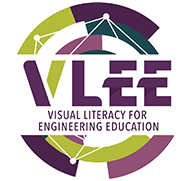-
Module 1 – What is Visual Literacy for Engineers? 9
-
Video Overview of Module 1Module1.1
-
ACTIVITY: Download Module 1’s Learning ObjectivesModule1.2
-
Why Visual Literacy is importantModule1.3
-
Case Study on Importance of Visual LiteracyModule1.4
-
The role of Visual Literacy in EngineeringModule1.5
-
Visual Literacy and CreativityModule1.6
-
Visual Literacy in EngineeringModule1.7
-
Digital technologies and Visual LiteracyModule1.8
-
Test your knowledgeQuiz1.15 questions
-
-
Module 2 – Digital Visual Tools for the effective use of images, graphics or objects for engineering tasks 5
-
Video Overview of Module 2Module2.1
-
ACTIVITY: Download Module 2’s Learning ObjectivesModule2.2
-
Using Visuals as Resources in an Engineering ContextModule2.3
-
Selecting the adequate tool for engineering tasksModule2.4
-
Test your knowledgeQuiz2.14 questions
-
-
Module 3 – Digital Visual Tools for Engineering Interpretation 7
-
Video Overview of Module 3Module3.1
-
ACTIVITY: Download Module 3’s Learning ObjectivesModule3.2
-
Interpreting Visually in an Engineering ContextModule3.3
-
Using Unity to “Interpret Forms”Module3.4
-
Using Autocad to “Interpret Graphics”Module3.5
-
Using Mathlab to “Interpret Data”Module3.6
-
Test your knowledgeQuiz3.15 questions
-
-
Module 4 – Digital Visual Tools for Engineering Analysis 12
-
Video Overview of Module 4Module4.1
-
ACTIVITY: Download Module 4’s Learning ObjectivesModule4.2
-
Visualization techniques’ role in analytical processesModule4.3
-
Basic visualization typesModule4.4
-
Main directions of visualization techniques application in scientific analysisModule4.5
-
Engineering disciplines that use various forms of visual analysisModule4.6
-
New possibilities of engineering analysis in a digital worldModule4.7
-
Data is everything, hence in a way everything can be visualizedModule4.8
-
Visual analysis of engineering data representation in visualizations of BI systemsModule4.9
-
Case Study 1Module4.10
-
Case Study 2Module4.11
-
Test your knowledgeQuiz4.15 questions
-
-
Module 5 – Digital Visual Tools for Solving Engineering problems 6
-
Video Overview of Module 5Module5.1
-
ACTIVITY: Download Module 5’s Learning ObjectivesModule5.2
-
Solving Visually in an Engineering ContextModule5.3
-
Using UML Diagramming Tool to “Visualise Solutions”Module5.4
-
Using Unity to “Explore”Module5.5
-
Test your knowledgeQuiz5.15 questions
-
-
Module 6 – Digital Visual Tools for Creating Engineering concepts and data 6
-
Video Overview of Module 6Module6.1
-
ACTIVITY: Download Module 6’s Learning ObjectivesModule6.2
-
Creating Visually in an Engineering ContextModule6.3
-
Using Coogle to “Envision”Module6.4
-
Using Autocad LT to “Create Forms”Module6.5
-
Test your knowledgeQuiz6.15 questions
-
-
Module 7 – Digital Visual Tools for Engineering Communication 6
-
Video Overview of Module 7Module7.1
-
ACTIVITY: Download Module 7’s Learning ObjectivesModule7.2
-
Communicating Visually in an Engineering ContextModule7.3
-
Using Thinklink to “SHARE”Module7.4
-
Using Draw IO to “DESCRIBE”Module7.5
-
Test your knowledgeQuiz7.15 questionsFinal
-
New possibilities of engineering analysis in a digital world
All forms of engineering analysis become increasingly improved. People are slowly reaching the limits of their biological capabilities, but they are not slowing down thanks to computerization, which also supports all research initiatives. Instrumentation becomes more accurate and precise resulting in more data to be analyzed and processed. The development of ICT has contributed to the creation of completely new environments and IT tools. Humanity can now look further, see more and know more than ever.
There has been the emergence of virtual reality and augmented reality. With its help, experiencing the impossible becomes real. It is possible to conduct experiments that have not been possible so far. However, there is a specific danger related to this state of affairs. It is not only the constantly growing demand for computing power but, above all, the threat of information chaos. Paradoxically, obtaining more information may cause difficulties in understanding it and even disrupt the whole cognitive process. Therefore, there is a need for simple and easy to use solutions that will enable control, quick aggregation and visualization of data. It should be emphasized that in the chaos of data the information that is not described is completely unnecessary and sometimes even harmful for the researcher.
